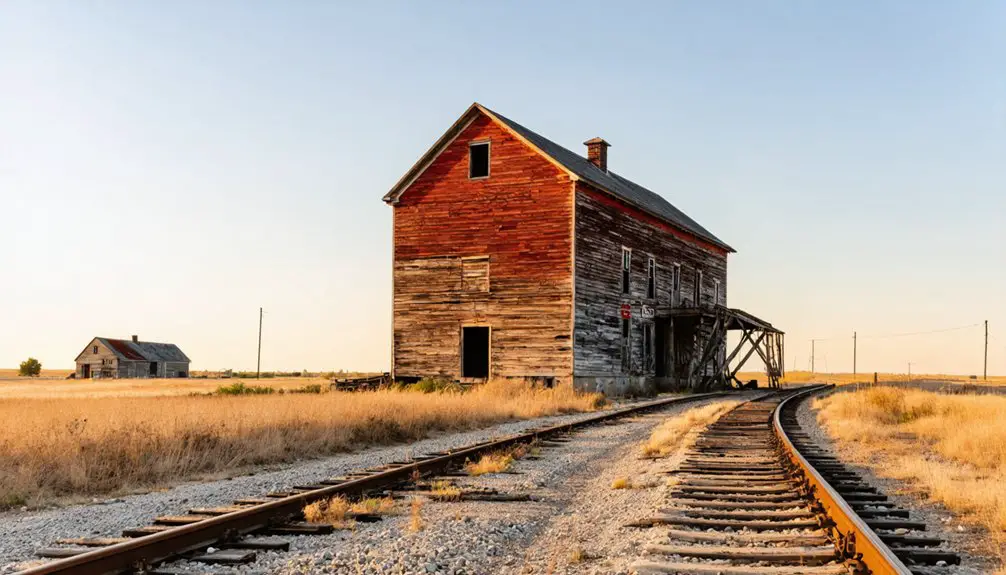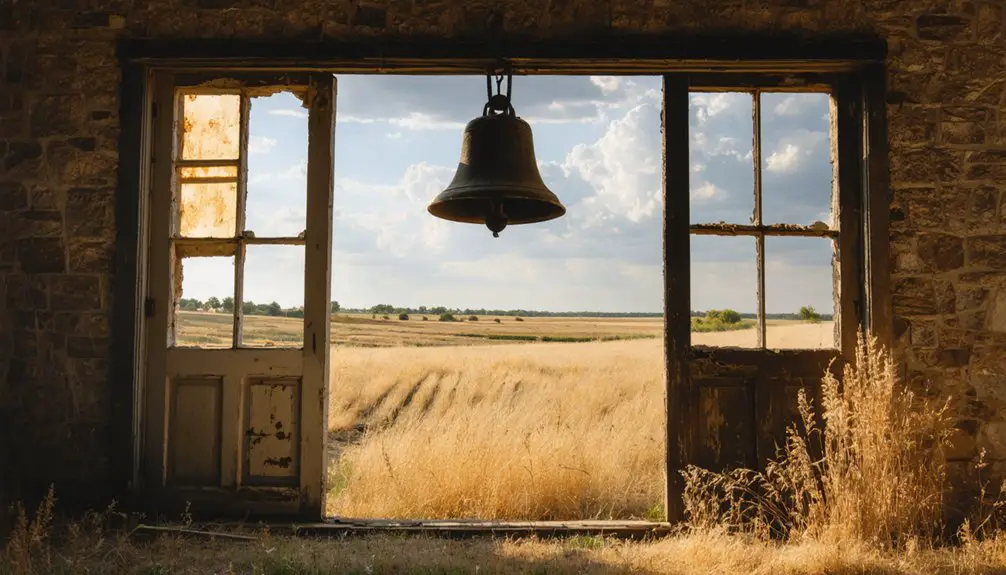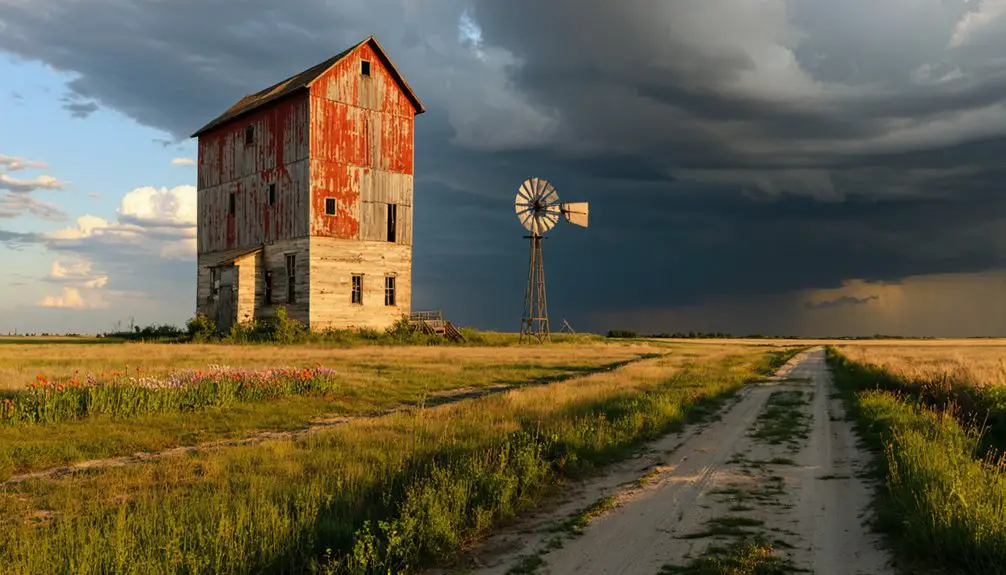You’ll find Boyd’s ghost town remnants in Kansas, where it began as Maherville in 1873 when the Missouri Pacific Railroad established a grain shipping point between Russell and Great Bend. The town, renamed Boyd, thrived with a post office and agricultural commerce until 1937. Today, you can explore original structures including distinctive post-rock limestone buildings and grain silos that tell the story of Kansas’ railroad boom and eventual rural decline.
Key Takeaways
- Originally called Maherville, Boyd was established in 1873 by Missouri Pacific Railroad as a grain shipping point in Kansas.
- The town reached its peak population of 40 residents in 1910 before declining due to decreased railroad usage.
- Post office closure in 1937 marked a significant milestone in Boyd’s transformation into a ghost town.
- Several original stone buildings remain, including post-rock limestone structures that showcase late 19th-century architectural styles.
- The town’s abandonment resulted from agricultural mechanization, highway bypasses, and youth migration to larger cities.
The Birth of a Railroad Town
When the Missouri Pacific Railroad established a station in 1873, it marked the birth of Maherville, a small Kansas settlement that would later become Boyd. The railroad’s arrival sparked the community’s growth, connecting settlers to crucial trade routes and creating opportunities for agricultural commerce in the region.
The railroad industry’s growth helped many African Americans find work, similar to Pullman porter opportunities that paid $25 a month in the early 1900s. You’ll find the town’s railroad history deeply intertwined with its development milestones. By June 1874, a post office opened, signaling the community’s expanding infrastructure. The settlement quickly became a bustling shipping point, and by 1878, grain exports dominated the local economy.
Located along the stage line between Russell and Great Bend, Maherville’s strategic position offered residents regular mail service and indispensable transportation links. The Missouri Pacific Railroad station’s presence attracted new settlers and businesses, transforming a simple railway stop into a proper trading hub. Weekly mail deliveries were handled by postmaster Samuel S. Shields, ensuring reliable communication for the growing community.
From Maherville to Boyd: A Name’s Evolution
Before becoming Boyd, you’d find this early Kansas settlement under the name Maherville in historical postal and land records from the mid-19th century.
When the railroad established its presence in the region, officials strategically rebranded the community as Boyd, marking a significant shift in both name and economic prospects. Similar to Marysville’s growth after the arrival of the first train in 1870, Boyd sought to capitalize on railway connections. Like many Kansas ghost towns, Boyd’s fate was ultimately tied to changing transportation routes and economic shifts.
You can trace the complete transformation through official documents showing the post office’s formal adoption of the Boyd designation, solidifying the town’s new identity as a railroad hub.
Railroad Station Origins
As the Missouri Pacific Railroad expanded through Kansas in 1873, a small station named Maherville emerged along its tracks, marking the beginning of what would later become Boyd. The railroad’s impact was immediate, establishing the settlement as a crucial grain export point and securing its position on the stage line between Russell and Great Bend. Much like the freight room exhibits found in historic depots today, the station was essential for storing and moving agricultural products.
You’ll find the community’s growth reflected in the establishment of its post office on June 22, 1874, with Samuel S. Shields serving as postmaster. Like the Marysville depot that would be built decades later at 39°50′39″N 96°38′57″W, this station played a vital role in connecting regional communities.
The station’s strategic location in Eureka Township, Barton County – four miles west of Hoisington and twelve miles northwest of Great Bend – made it an ideal hub for agricultural distribution. By 1878, Maherville had solidified its role in the region’s grain trade, though it remained modest in size with only 40 residents by 1910.
Name Change Mystery
Despite its thirty-year history as Maherville, the town underwent a significant name change on January 27, 1904, becoming officially known as Boyd.
The name change significance remains shrouded in mystery, as historical records don’t provide a clear explanation for choosing “Boyd” specifically. You’ll find this transformation occurred during the town’s development into a trading and shipping point, when its population reached about 40 residents by 1910. Like Blattner Manufacturing Company, which was established in nearby Rozel, Kansas in 1906, Boyd emerged during a period of significant rural development.
While the historical implications of such name changes often reflected new ownership, railroad officials, or postal regulations, Boyd’s case leaves us guessing.
What’s certain is that the new name stuck, remaining with the post office until its closure in 1937 and living on through the town’s remaining structures, including grain silos and a stone commercial building.
Post Office Identity Shift
The postal service evolution from Maherville to Boyd marked a defining chapter in the town’s administrative development.
You’ll find evidence of this change in USPS records showing how Maherville’s original post office underwent closure, leading to mail rerouting through neighboring towns before Boyd’s postal identity emerged.
This shift wasn’t just administrative – it fundamentally changed how the community functioned. Similar to modern closures like in Matherville where residents had to adapt to mail pickup at Preemption, community adjustments were necessary.
When you examine historical documents, you’ll see the impact rippled through daily life as residents adapted to new mailing addresses and communication patterns. Like Mississippi State College’s one mile east location from Starkville, Boyd’s distance from surrounding communities affected mail delivery routes.
The post office’s identity change from Maherville to Boyd reflected broader changes in rural postal services, with routes and service areas adjusting to meet evolving local needs.
Today, postal records and digitized archives preserve this evolution, demonstrating how small-town post offices often tracked with community name changes.
Daily Life and Commerce on the Prairie
Life in Boyd centered around its strategic position as a Missouri Pacific Railroad station, established in 1873.
Like the residents of early Columbia settlers, the community relied heavily on local services such as blacksmiths and supply stores to meet their basic needs.
The prairie lifestyle meant adapting to seasonal agricultural cycles while relying on local blacksmiths and shopkeepers for basic needs.
Agricultural Legacy and Economic Foundations

Originally established as Maherville in 1873, Boyd’s agricultural identity emerged from its strategic position along the Missouri Pacific Railroad, where grain exports became the economic cornerstone by 1878.
You’ll find evidence of agricultural sustainability in the town’s early infrastructure, including grain silos and storage facilities that supported the farming community’s economic resilience.
With a population of 40 by 1910, Boyd served as an essential hub where you could witness the seamless integration of rail transport, postal services, and agricultural commerce.
Boyd’s modest population of 40 belied its importance as a vital hub connecting rail transport, mail service, and agricultural trade.
The town’s strategic location near Great Bend and Hoisington strengthened its position in regional trade networks.
However, shifts in farming practices, transportation methods, and market dynamics eventually led to Boyd’s decline, marked by its post office closure in 1937 and its eventual transformation into a ghost town.
Architectural Remnants and Post-Rock Heritage
Standing as silent witnesses to Boyd’s past, several original structures remain at the former townsite, including a distinctive stone commercial building that exemplifies late 19th-century rural Kansas architecture.
The buildings showcase post-rock limestone construction, a material prized throughout Barton County for its durability and weather resistance.
You’ll find this architectural preservation legacy reflected in:
- Grain silos and agricultural structures that dominated Boyd’s economic landscape
- Native post-rock limestone buildings that connect to regional construction traditions
- Utilitarian farm buildings designed for grain storage and exportation
- Historic commercial structures dating back to Boyd’s 1873 origins as Maherville
Today’s ghost town heritage faces ongoing preservation challenges from Kansas weather and lack of maintenance since 1937, yet these remnants continue telling the story of rural Kansas’ agricultural and railroad boom era.
The Path to Abandonment

When the Missouri Pacific Railroad established Boyd as a station in 1873, the town’s founders couldn’t have predicted its eventual decline. Initially thriving as a grain shipping point with a population of 40 by 1910, Boyd’s transportation decline began as railroad usage diminished and highways bypassed the community.
The town’s community resilience was tested through multiple challenges. You can trace Boyd’s path to abandonment through key events: agricultural mechanization reduced local labor needs, the post office closed in 1937, and younger residents migrated to larger cities for better opportunities.
The devastating effects of the 1930s Dust Bowl, combined with economic centralization to nearby towns like Great Bend, accelerated Boyd’s demise. Without essential services and faced with dwindling population, the once-promising railroad stop gradually faded into abandonment.
Frequently Asked Questions
What Happened to Boyd’s Original Railroad Tracks and Station?
You’ll find Boyd’s railroad history vanished as the town became a ghost town – the tracks were likely dismantled after service ended, and the station disappeared when the post office closed in 1937.
Are There Any Living Former Residents of Boyd Still in Kansas?
You won’t find documented living former residents of Boyd in Kansas today. While community memories might persist in surrounding towns, records don’t show any original Boyd inhabitants remaining in the area.
What Natural Disasters or Severe Weather Events Affected Boyd’s History?
While you’ll find records of tornado impacts and flood damage in nearby Kansas towns, there’s no documented catastrophic weather event specifically striking Boyd, though regional severe weather likely affected its gradual decline.
Were There Any Schools or Churches Established in Boyd?
Like a town without Wi-Fi, you won’t find documented school history or church establishment in Boyd’s records. Historical sources suggest the small railroad community never developed these essential community institutions.
Did Any Notable Crimes or Incidents Occur in Boyd’s History?
You won’t find any documented crimes specific to Boyd in official records, though local folklore hints at mysterious disappearances. Unlike nearby areas with verified criminal histories, Boyd’s dark tales remain unconfirmed.
References
- https://legendsofkansas.com/boyd-kansas/
- https://traveloregon.com/things-to-do/culture-history/ghost-towns/boyd/
- https://theclio.com/entry/189284
- https://legendsofkansas.com/kansas-ghost-town-list/
- https://freepages.rootsweb.com/~gtusa/history/usa/ks.htm
- https://en.wikipedia.org/wiki/Frank_L._Boyd
- https://www.ksgenweb.org/archives/1919ks/b/boyds.html
- https://www.ksre.k-state.edu/news/stories/2018/01/Kansas-Profile-Railroad-Huck-Boyd.html
- https://en.wikipedia.org/wiki/Boyd
- https://legendsofkansas.com/marysville/



